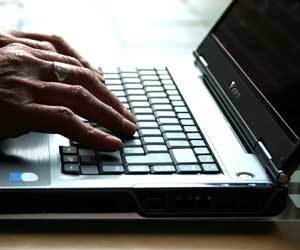Cleaning your Keyboard in 2 Minutes or Less
This method will make your keyboard reasonably clean in just a minute or two.
- Unplug
%22%20transform%3D%22translate(.5%20.5)%22%20fill-opacity%3D%22.5%22%3E%3Cellipse%20fill%3D%22%2377b3e0%22%20rx%3D%221%22%20ry%3D%221%22%20transform%3D%22matrix(68.91787%205.10461%20-1.55036%2020.9315%20149%20149)%22%2F%3E%3Cellipse%20fill%3D%22%23001748%22%20rx%3D%221%22%20ry%3D%221%22%20transform%3D%22rotate(-30.6%20196.8%20-102.5)%20scale(15.57892%2039.41352)%22%2F%3E%3Cpath%20fill%3D%22%23060029%22%20d%3D%22M0%20136h49v14H0z%22%2F%3E%3Cellipse%20fill%3D%22%234581ae%22%20cx%3D%2222%22%20cy%3D%22101%22%20rx%3D%2235%22%20ry%3D%2220%22%2F%3E%3C%2Fg%3E%3C%2Fsvg%3E) or power off the keyboard.
or power off the keyboard. - Hold it upside-down (preferably outside or over a trash can) and shake it, toaster-style, to get the big stuff out.>
- Clean between the keys using one of the following methods (depending on your inclination and the tools you have available):
- With the keyboard inverted, blow hard through the keys, being careful not to shower yourself in keyboard crud.
- If you have compressed air available, or a bulb air blaster, blast the cracks and crevices with air while the keyboard is inverted. You may want to go outside, crud will fly.
- If you have one available, use a thin/fluffy brush to sweep out between the keys. This works best with the keyboard either inverted or held up 90 degrees. Common brushes that work for this include watercolor brushes, makeup brushes, old toothbrushes, and those cleaning brushes that come with electric razors.
- With the keyboard still unplugged or off, wipe down the keys with an antibacterial surface cleaner. To get the edges of the keys, fold your cloth around a credit card or other stiff, thin object.
- If you desire, repeat the previous step using your favorite disinfectant – rubbing alcohol, Lysol, etc.
- Done!
Cleaning Spills from your Keyboard and Unsticking Stuck Keys
If your keyboard is in need of a deeper cleaning or has had something spilled on it, follow this process.
- If something is spilled on your keyboard, turn it upside-down as soon as humanly possible to avoid the liquid/material from gaining entry to the printed circuit board beneath the keys.
- Immediately unplug or power the keyboard off.
- If it’s wet, keep it inverted and wipe it down as well as possible, then place it in a warm, ventilated area to completely dry. If it get really wet, placing it in a cardboard box on top of some desiccant, placing it next to a fan so that the fan can pass air freely over and under it can help it dry faster. Do not continue until it is completely dry!
- Once dry, remove the keys (if your keys are removable). Be careful as some keys (like the space bar and shift keys) often have little plastic or metal bars that stabilize them when you press on them. Take a picture of your keyboard before doing this so you can remember where the keys go.
- To clean the keys (assuming they are removable), you can place them in the silverware basket in your dishwasher (but remove them before the drying cycle to prevent warping/fading) or wash them manually in the sink. Let them dry completely before replacing them.
- With the keys removed, remove what mess you are able to reach using a soft cloth dampened with isopropyl alcohol. If there’s chunks, gently scrape them up with a plastic butter knife or similar object. Q-tips can be useful for nooks and crannies.
- If the spill has made it past this point and into the keyboard case, it’s likely to never work again – however – you can disassemble the keyboard by unscrewing the visible screws in the case and cleaning what you are able to reach. Be very careful when cleaning the circuit board – don’t scrub it – gently work off spills using as little isopropyl alcohol as is possible on a small q-tip. Don’t saturate the circuit board, just be patient and take your time.
- When the spill has been completely cleaned up, set everything out someplace to dry completely, then reassemble and test. Fingers crossed!
Protecting your Keyboard
- If you’ve got a keyboard in a high-risk area, perhaps used by children, consider wrapping it with clear, plastic wrap to keep it clean and free from spills.
Sources
- Home Comforts; The Art and Science of Keeping House by Cheryl Mendelson
- Green Housekeeping by Ellen Sandbeck
- How to Clean Practically Anything by Consumer Reports

 or power off the keyboard.
or power off the keyboard.







Works every time! Follow the directions on the can, and never ever spray the dust out of the keyboard while the computer is on.
Turn your keyboard upside down and shake it gently to get out as much of the loose stuff as you can. Then, use your vacuum cleaner’s hose attachment with the upholstery brush, just brush it over the top of the keyboard a few times to suck everything else out from between the keys. Or if your vacuum has a reverse setting (blow instead of suck), use the hose attachment to blow the dust out the same way you would with an air can.
Use a cleaning wipe to clean off the tops of the keys one at a time, being careful not to rub too hard and scrub the characters off. Once the tops of the keys are clean, double up the wipe and pull it down the rows between the keys.
If you eat or drink around your computer a lot, get a plastic keyboard cover to keep the crumbs and spills and dust out of the keyboard itself. You can wash the plastic cover in the sink with dish soap, then let it air dry completely before putting it back on your keyboard.
That nasty black stuff all over your keys is oil and dirt from your fingers! Use a gentle cleaning fluid and cotton swabs to clean off the affected keys.
First, turn the keyboard upside-down and shake out any crumbs, hair, etc.
Then you can either:
1. Fold a wet wipe so it’s somewhat rigid and use it to scrub the sides of the keys, then the tops.
or
2. Pull the keys off of the keyboard and clean them (they are dishwasher safe too!). Be careful though, long keys like the space bar and shift have little bars which make removal a little more complex.
Use a cotton swap soaked in rubbing alcohol to clean the tops of and in between the keys.
There are _always_ methods requiring the complete dismantling, cleaning, and re-assembly of the keyboard, but what follows is an almost surefire method that has never (yet) let me down…
Believe it or not, if you’ve used all the other methods, (and only _if_ the keyboard is not totally ruined already) you can take it to the shower. Mind you don’t get other things in it whilst you are there, hmmm? Generously douse the keyboard with liquid soap (dish soap, preferably, since it won’t leave any residue) and flush it with water as hot as you can stand for about a minute. When finished, rinse it from as many directions as you can – you can’t begin to imagine what you’re going to see float down the drain!
After following these steps DO NOT plug the keyboard into ANYTHING! Vigorously shake any excess fluids out of the keyboard. Suspend the (now wet) keyboard upside down (and at a slight angle) over or near a safe heat source, such as a baseboard heater or a floor heating vent. Do not let it get so close as to endanger the device by melting it. Leave the keyboard there for at least two days. After ensuring that there is no moisture remaining whatsoever, continue to use your keyboard as normal – golfing, swordplay, and, er, yes…computing. Next time, keep it away from your soda pop, or whatever grunge you might have spilled on it.
If, for some inexplicable reason this doesn’t work; you’re still frightened to take it apart; or you can’t spring for the price of a decent used keyboard…you really should keep a spare mouse and keyboard at all times if you’re serious about computing.
Now, if you’re completely desperate, you could consider using a _LIGHT_ solvent which doesn’t melt plastic. Since there are _MANY_ solvents on the market (alcohol all the way to xylene), _you_ must make a wise choice and then test it on the bottom of the keyboard where it won’t be noticed if it does melt the plastic. (HINT: Keep completely away from the xylene – not only will it it rot your keyboard, it will also rot your brain.) If you’ve found a suitably safe solvent, follow the procedure outlined above for hot, soapy water, only no heat, and no soap. Use the solvent in a well ventilated space – say, outside – and away from any pets, children, favorite plants, etc. When drying the solvent laden keyboard, it should dry in about half the time that it takes the hot soapy water, but keep it away from any sparks, open flame or other sources of ignition. Be ENTIRELY sure that no solvent remains in the keyboard before plugging it back in – your computer and your landlord/parents/spouse/neighbors will thank you for it.
If you’ve followed all of these steps and it still doesn’t work, then I pronounce your keyboard dead.
Throw it in the dishwasher, top rack. Dry excessively afterward with a hair dryer. Works fine.
I second the dishwasher method. Nothing could be easier. Just be sure to let it dry out completely before plugging it back in.
Use a Dremel rotary drill with polishing bit (the actual bit is a screw-mandrel that you attach cotton polishing pieces to). Gets in between the keys nice and easy and super clean afterward.
I use a good vodka to clean in-between the keys, etc. It evaporates quickly and is cheap. Some unused paintbrushes and one is good to go. Plus, once you are done, there should be some left in the bottle so you can celebrate having a clean keyboard.
Take a picture of your keyboard with a digital camera. Use a fingernail file or pen to pop the keys off. Soak the keys in hot, soapy water and clean the keyboard with a damp cloth. Using the pic you took of the keyboard, put the keys (dried) back where they belong.
These are all great suggestions, but most of all, funny!